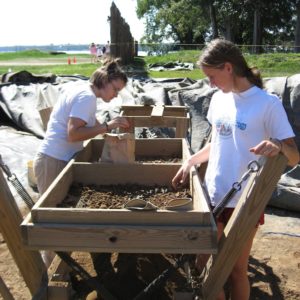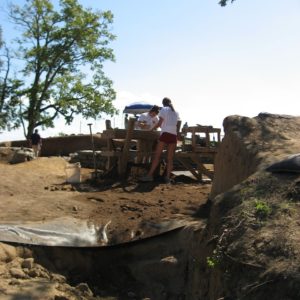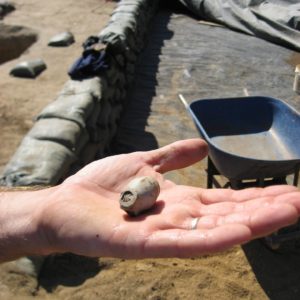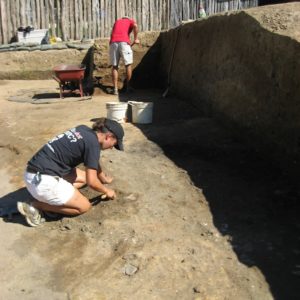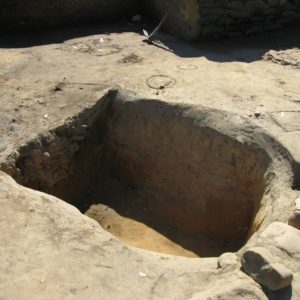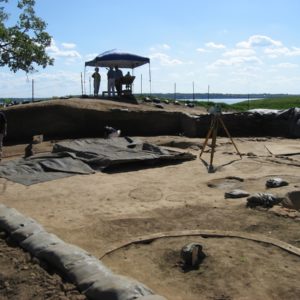Did the colonists at Jamestown build a fort within a fort? That’s the question the Jamestown Rediscovery archaeologists are asking themselves as a peculiar ditch discovered inside the walls of James Fort has them reassessing the nature of some of their previous finds and using their experience to hypothesize about the function of the ditch itself.
A ditch located next to the ca. 1617 addition to a large ca. 1611 building inside James Fort is currently being excavated. The building is one of two large buildings with cobblestone foundations that were constructed just inside of and parallel to the western palisade wall. It is thought to have been the residence of the governor of the colony of Virginia. The ditch runs up to and neatly ends at the wall of the building, evidence that it was constructed while the building was standing. Other ditches have been found inside the fort before, but they have turned out to be boundary ditches to divide property or to corral livestock. These ditches often will “cut through” or transect fort-period features, meaning that the ditches are younger in age than the features they pass through. Boundary ditches also usually are constructed so that the walls of the ditch form a “v” shape where they meet at the bottom. This helps keep livestock on their side of the ditch. The newly discovered ditch has a substantial flat bottom seen more in defensive ditches.
The archaeologists are removing clay layers above the ditch in order to find and follow its path within James Fort. Once they uncover the full length of the ditch they will be able to better assess its form and function. If the ditch does turn out to be part of a larger defensive structure within James Fort it is interesting to note that the date of construction supported by the archaeological evidence (ca. 1617) was a time of volatile relations with the local Virginia Indians and amongst the colonists themselves. The acting governor of the time, Samuel Argall, was known as a harsh enforcer of the laws of the colony, a duty he thought necessary to rectify the disorder prevalent in the colony upon his election in 1616.
The presence of the ditch is causing the archaeologists to reconsider the function of other nearby features. A small brick structure next to the governor’s house may have been a small guardhouse designed to give shelter to a soldier protecting the residence. Even more interesting is the possibility that a brick foundation thought to be for a bay window may in fact have supported a tower or gun emplacement. At this point, the archaeologists simply don’t know for sure what the exact nature of these features are, but this is a good example of how new excavations can greatly alter the understanding of a previously discovered feature.
Excavations near the ditch have uncovered an area with a large amount of ash mixed in the soil. The ash could be the remains of a structure burned during one of the numerous times that Jamestown was afflicted by fire. The excavation of the subterranean feature thought to be a well or cellar has temporarily been put on hold as the Jamestown Rediscovery team tries to flesh out the nature of the ditch and the other features nearby.
related images
- Archaeologist Mary Anna Richardson points to the ditch profile
- Archaeologists screen through dirt excavated from the Confederate fort fill
- The tarp visible is underneath a backfilled part of the site. The tarp and backfilled soil above it protect the excavations for possible future archaeologists.
- View of mid-17th century pipe bowl. ‘WC’ maker’s mark is visible on the heel. Pipes bearing this mark have been found in other 17th century settlement
- Possible defensive ditch in foreground
- Archaeologist Mary Anna Richardson excavates an area containing a large amount of ash
- Archaeologist Luke Pecoraro excavates a section of earth inside James Fort.
- Ditch terminating at ca.1617 cobblestone foundation
- View of the dig at James Fort. Backfilled early 17th century well is in the foreground.




